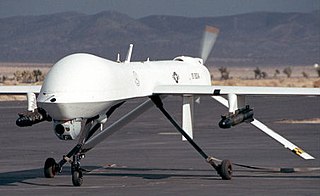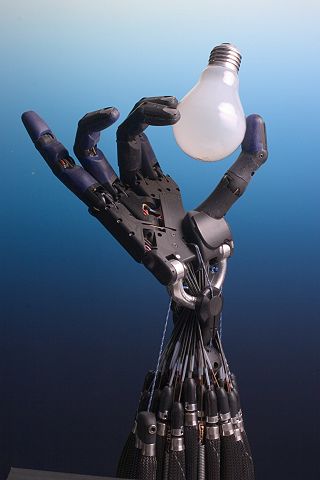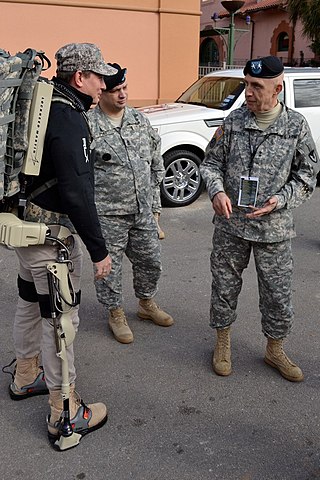Related Research Articles

A humanoid robot is a robot resembling the human body in shape. The design may be for functional purposes, such as interacting with human tools and environments, for experimental purposes, such as the study of bipedal locomotion, or for other purposes. In general, humanoid robots have a torso, a head, two arms, and two legs, though some humanoid robots may replicate only part of the body, for example, from the waist up. Some humanoid robots also have heads designed to replicate human facial features such as eyes and mouths. Androids are humanoid robots built to aesthetically resemble humans.

Military robots are autonomous robots or remote-controlled mobile robots designed for military applications, from transport to search & rescue and attack.
GuRoo is a humanoid robot developed at the Mobile Robotics Laboratory in the School of Information Technology and Electrical Engineering at the University of Queensland. The design of the GuRoo is based on the human form and it is kept as anthropomorphic as possible. GuRoo is completely autonomous. It is used for research in different areas including dynamic stability, human-robot interaction and machine learning. GuRoo competes in the annual RoboCup. The goal of this competition is to foster the development of robotics through an annual soccer competition. It is the dream of the RoboCup federation to develop a team of fully autonomous humanoid robots, to play against and beat the human team that wins the World Cup in the year 2050.

ASIMO is a humanoid robot created by Honda in 2000. It is displayed in the Miraikan museum in Tokyo, Japan. On 8 July 2018, Honda posted the last update of Asimo through their official page stating that it would be ceasing all development and production of Asimo robots in order to focus on more practical applications using the technology developed through Asimo's lifespan. The name was chosen in honor of Isaac Asimov. It made its last active appearance in March 2022, over 20 years after its first, as Honda announced that they are retiring the robot to concentrate on remote-controlled, avatar-style, robotic technology.

An unmanned ground vehicle (UGV) is a vehicle that operates while in contact with the ground and without an onboard human presence. UGVs can be used for many applications where it may be inconvenient, dangerous, or impossible to have a human operator present. Generally, the vehicle will have a set of sensors to observe the environment, and will either autonomously make decisions about its behavior or pass the information to a human operator at a different location who will control the vehicle through teleoperation.

A mobile robot is an automatic machine that is capable of locomotion. Mobile robotics is usually considered to be a subfield of robotics and information engineering.

BigDog is a dynamically stable quadruped military robot that was created in 2005 by Boston Dynamics with Foster-Miller, the NASA Jet Propulsion Laboratory, and the Harvard University Concord Field Station. It was funded by DARPA, but the project was shelved after the BigDog was deemed too loud for combat.

iCub is a 1 metre tall open source robotics humanoid robot testbed for research into human cognition and artificial intelligence.
Boston Dynamics is an American engineering and robotics design company founded in 1992 as a spin-off from the Massachusetts Institute of Technology. Headquartered in Waltham, Massachusetts, Boston Dynamics has been owned by the Hyundai Motor Group since December 2020, but having only completed the acquisition in June 2021.
Tomotaka Takahashi is a Japanese roboticist and founder of Kyoto University's ROBO-GARAGE since 2018. Takahashi creates humanoid robots known for their smooth, fluid motions and sleek appearance. Having built many humanoid robots entirely by himself, from simple concepts to production, Takahashi's designs have been featured in several art exhibitions celebrating the creation of Astroboy, Time Magazine's Coolest Inventions of 2004, and promotions for Bandai, Panasonic, and Pepsi. He has also worked with toy companies to produce relatively inexpensive robots for the hobby market, including those for Kyosho.

Robotics is the branch of technology that deals with the design, construction, operation, structural disposition, manufacture and application of robots. Robotics is related to the sciences of electronics, engineering, mechanics, and software.

Robotics is an interdisciplinary branch of electronics and communication, computer science and engineering. Robotics involves the design, construction, operation, and use of robots. The goal of robotics is to design machines that can help and assist humans. Robotics integrates fields of mechanical engineering, electrical engineering, information engineering, mechatronics engineering, electronics, biomedical engineering, computer engineering, control systems engineering, software engineering, mathematics, etc.

Human Universal Load Carrier, or HULC, is an un-tethered, hydraulic-powered anthropomorphic exoskeleton developed by Professor H. Kazerooni and his team at Ekso Bionics. It is intended to help soldiers in combat carry a load of up to 200 pounds at a top speed of 10 miles per hour for extended periods of time. After being under development at Berkeley Robotics and Human Engineering Laboratory since 2000, the system was announced publicly at the AUSA Winter Symposium on February 26, 2009, when an exclusive licensing agreement was reached with Lockheed Martin. Although the exoskeleton is powered and can be used, the project was a failure as it hindered certain movements and actually increased strain on muscles, going directly against what a powered exoskeleton is supposed to do.
Vecna Technologies is a healthcare information technology company with products including the Patient Information Exchange and QC PathFinder. Vecna shares its origin with an independent sister company Vecna Robotics that develops and applies robotics technology to logistics and industrial markets.
The following outline is provided as an overview of and topical guide to robotics:

A powered exoskeleton is a mobile machine that is wearable over all or part of the human body, providing ergonomic structural support and powered by a system of electric motors, pneumatics, levers, hydraulics or a combination of cybernetic technologies, while allowing for sufficient limb movement with increased strength and endurance. The exoskeleton is designed to provide better mechanical load tolerance, and its control system aims to sense and synchronize with the user's intended motion and relay the signal to motors which manage the gears. The exoskeleton also protects the user's shoulder, waist, back and thigh against overload, and stabilizes movements when lifting and holding heavy items.
Atlas is a bipedal humanoid robot primarily developed by the American robotics company Boston Dynamics with funding and oversight from the U.S. Defense Advanced Research Projects Agency (DARPA). The robot was initially designed for a variety of search and rescue tasks, and was unveiled to the public on July 11, 2013.

Counter-IED equipment are created primarily for military and law enforcement. They are used for standoff detection of explosives and explosive precursor components and defeating the Improvised Explosive Devices (IEDs) devices themselves as part of a broader counter-terrorism, counter-insurgency, or law enforcement effort.
Vecna Robotics, Inc. is an American robotics and technology company headquartered in Waltham, Massachusetts. Incorporated in 2018 as a spin-off from Vecna Technologies, the company specializes in automated material handling, hybrid fulfillment and workflow optimization for industrial applications.
References
- 1 2 3 4 5 6 7 8 Klein, Jonathan; Atwood, Tom (25 April 2007). "Vecna Robot Exclusive". Robot (7): 24. Archived from the original on 20 November 2010.
- 1 2 "Bear robot rescues wounded troops". BBC News. 7 June 2007.
- 1 2 3 4 5 6 Allen, Andrew (26 January 2011). "Interview by Sander Olson". Archived from the original on 20 December 2010.
- 1 2 "The BEAR Battlefield Extraction Assist Robot" (PDF). Vecna. Vecna Robotics. 1 March 2010. Archived from the original (PDF) on 25 October 2010.
- 1 2 "Battle Extraction Assist Robot". Military Channel. Retrieved 26 January 2011– via Discovery Channel.
- ↑ Ruppert, Barb (22 November 2010). "The Battlefield Extraction-Assist Robot to Rescue Wounded on Battlefield". American Military News. Archived from the original on 14 July 2011.
- ↑ "The BEAR™ — Battlefield Extraction-Assist Robot". Vecna. Vecna Robotics. Archived from the original on 23 October 2010.